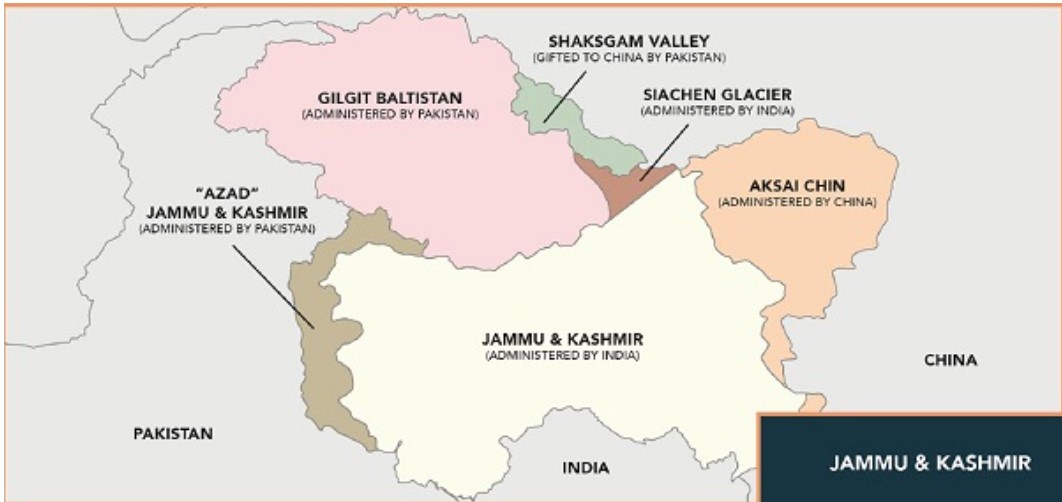Why in news?
Pakistan’s Law and Justice Ministry has finalised a draft legislation to incorporate Gilgit-Baltistan, the region known before 2009 as Northern Areas, as a province of the country.
Why is it a concern for India?
- India has for long asserted that Gilgit-Baltistan is an integral part of India.
- It is claimed by virtue of the legal, complete and irrevocable accession of Jammu & Kashmir to the Union of India in 1947.
- The area’s strategic importance for India has particularly increased in light of the China-Pakistan Economic Corridor (CPEC) agreement.
- Under the CPEC, China is investing hugely to develop the Gilgit-Baltistan area as part of its Belt and Road Initiative.
- Suggestively, Pakistan’s decision is under pressure from China to make clear the Gilgit-Baltistan’s status so that it does not undermine the legality of its projects there.
How did the dispute originate?
- Gilgit was part of the princely state of Jammu & Kashmir, but was ruled directly by the British.
- When Hari Singh (the Hindu ruler of the Muslim-majority J&Kstate) acceded to India in October, 1947, the Gilgit Scouts rose in rebellion, led by their British commander.
- The Gilgit Scouts also moved to take over Baltistan, which was then part of Ladakh, and captured Skardu, Kargil and Dras.
- In battles thereafter, Indian forces retook Kargil and Dras in August 1948.
- Before that, in November, 1947, a political outfit called the Revolutionary Council of Gilgit-Baltistan had proclaimed the independent state of Gilgit-Baltistan.
- It also declared it was acceding to Pakistan.
- Pakistan accepted the accession only to the extent of full administrative control.
- It chose to govern it directly under the Frontier Crimes Regulation, a law devised by the British to keep control of the restive tribal areas of the northwest.
- Following the India-Pakistan ceasefire of January, 1949, Pakistan entered into an agreement with the “provisional government” of “Azad Jammu & Kashmir”to take over its defence and foreign affairs.
- [The AJK covers the parts that had been occupied by Pakistani troops and irregulars.]
- Under this agreement, the “AJK” government also ceded the administration of Gilgit-Baltistan to Pakistan.

What is unique with the Gilgit-Baltistan area?
- In 1974, Pakistan adopted its first full-fledged civilian Constitution, which lists four provinces - Punjab, Sindh, Balochistan, Khyber Pakthunkhwa.
- The Pakistan-Occupied Kashmir (PoK) and Gilgit-Baltistan were not incorporated as provinces.
- [This was because Pakistan wanted the resolution of the Kashmir issue to be in accordance with UN resolutions that called for a plebiscite.]
- In 1975, PoK got its own Constitution, making it aself-governed autonomous territory and the people having rights and freedoms.
- However, Northern Areas continued to be administered directly by Islamabad (the Frontier Crimes Regulation was discontinued in 1997 but repealed only in 2018).
- The people of the minority Shia-dominated ‘Northern Areas’ did not have any political representation.
- They were considered Pakistani, but remained outside the ambit of constitutional protections available to those in other provinces and PoK.
What were the later administrative arrangements?
- In the 2000s, Pakistan began considering changes to its administrative arrangements in the Northern Areas.
- The post-9/11 dynamics of the region and increasing Chinese strategic moves necessitated this.
- In 2009, Pakistan brought in the Gilgit-Baltistan (Empowerment and Self-Governance) Order, 2009.
- It replaced the Northern Areas Legislative Council (NALC) with the Legislative Assembly and the Northern Areas got back the name of Gilgit-Baltistan.
What are the recent developments?
- A draft legislation for making Gilgit-Baltistan a province has been finalised as the 26th Constitutional Amendment Bill of Pakistan.
- Given its status as part of the unresolved Kashmir issue, Gilgit-Baltistan is expected to be given provisional provincial status.
- Aseparate set of amendments would be introduced to give Gilgit-Baltistan representation in Pakistan’s parliament, besides establishment of the Assembly.
Source: The Indian Express
